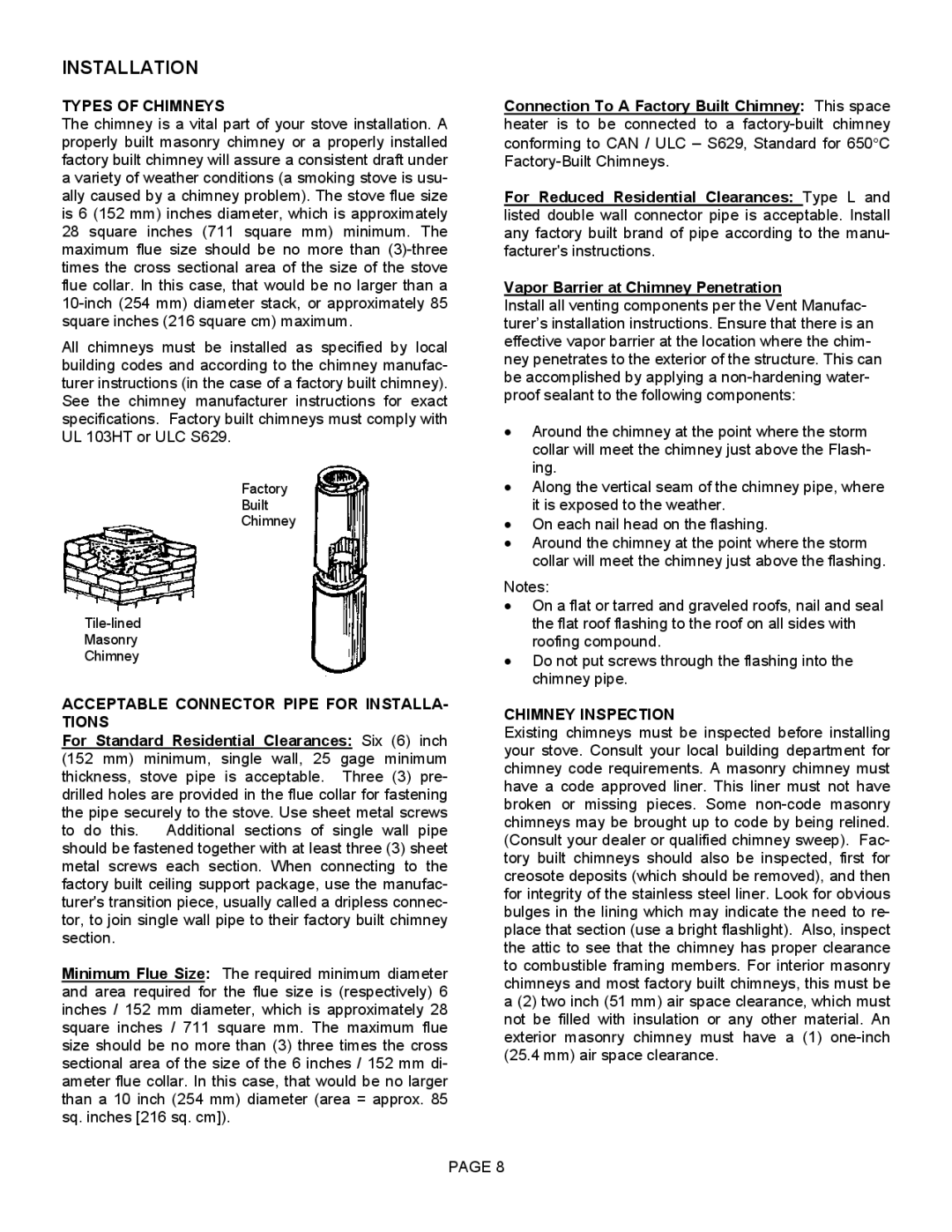
INSTALLATION
TYPES OF CHIMNEYS
The chimney is a vital part of your stove installation. A properly built masonry chimney or a properly installed factory built chimney will assure a consistent draft under a variety of weather conditions (a smoking stove is usu- ally caused by a chimney problem). The stove flue size is 6 (152 mm) inches diameter, which is approximately 28 square inches (711 square mm) minimum. The maximum flue size should be no more than
All chimneys must be installed as specified by local building codes and according to the chimney manufac- turer instructions (in the case of a factory built chimney). See the chimney manufacturer instructions for exact specifications. Factory built chimneys must comply with UL 103HT or ULC S629.
Factory
Built
Chimney
Masonry
Chimney
ACCEPTABLE CONNECTOR PIPE FOR INSTALLA- TIONS
For Standard Residential Clearances: Six (6) inch (152 mm) minimum, single wall, 25 gage minimum thickness, stove pipe is acceptable. Three (3) pre- drilled holes are provided in the flue collar for fastening the pipe securely to the stove. Use sheet metal screws to do this. Additional sections of single wall pipe should be fastened together with at least three (3) sheet metal screws each section. When connecting to the factory built ceiling support package, use the manufac- turer's transition piece, usually called a dripless connec- tor, to join single wall pipe to their factory built chimney section.
Minimum Flue Size: The required minimum diameter and area required for the flue size is (respectively) 6 inches / 152 mm diameter, which is approximately 28 square inches / 711 square mm. The maximum flue size should be no more than (3) three times the cross sectional area of the size of the 6 inches / 152 mm di- ameter flue collar. In this case, that would be no larger than a 10 inch (254 mm) diameter (area = approx. 85 sq. inches [216 sq. cm]).
Connection To A Factory Built Chimney: This space heater is to be connected to a
For Reduced Residential Clearances: Type L and listed double wall connector pipe is acceptable. Install any factory built brand of pipe according to the manu- facturer's instructions.
Vapor Barrier at Chimney Penetration
Install all venting components per the Vent Manufac- turer’s installation instructions. Ensure that there is an effective vapor barrier at the location where the chim- ney penetrates to the exterior of the structure. This can be accomplished by applying a
•Around the chimney at the point where the storm collar will meet the chimney just above the Flash- ing.
•Along the vertical seam of the chimney pipe, where it is exposed to the weather.
•On each nail head on the flashing.
•Around the chimney at the point where the storm collar will meet the chimney just above the flashing.
Notes:
•On a flat or tarred and graveled roofs, nail and seal the flat roof flashing to the roof on all sides with roofing compound.
•Do not put screws through the flashing into the chimney pipe.
CHIMNEY INSPECTION
Existing chimneys must be inspected before installing your stove. Consult your local building department for chimney code requirements. A masonry chimney must have a code approved liner. This liner must not have broken or missing pieces. Some
PAGE 8
